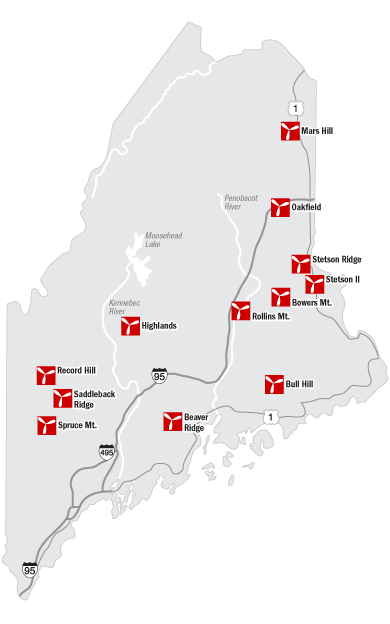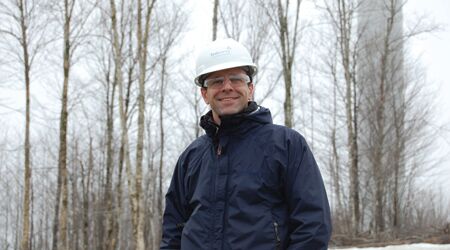Federal tax changes and a volatile natural gas market buffet wind development
Is Maine's wind power industry thriving or dying? While the question might seem hyperbolic, there's plenty of evidence for either proposition in what has been an unusually turbulent period for the state's first new, commercially viable source of electricity since the nuclear industry was in its heyday.
The Natural Resources Council of Maine lists 19 industrial-scale wind projects statewide that are operating, being permitted or in development — an impressive number, given that the first completed wind farm, in Mars Hill, began operating just five years ago. To date, well over $1 billion has been invested, leading some economists to describe wind as the biggest new industry to arrive in rural Maine since the paper industry took root.
Three of the leading developers, First Wind of Boston, Patriot Renewables of Quincy, Mass., and Independence Wind of Portland have collectively invested $765 million in operating farms, with another $431 million in permitted projects.
But there's also no denying that wind power development is facing serious headwinds. The three most significant issues are plunging natural gas prices, the imminent expiration of the federal tax credit that subsidizes new projects and an uncertain political climate in Maine.
The playing field
Natural gas prices are affecting all new electric generation sources, not just wind, but since it is the market clearing or equilibrium price for new contracts in Maine, it represents a particular challenge.
"Nobody knows just what's driving prices down, but they're extraordinarily low," says Rob Gardiner, the remaining principal with Independence Wind, since his partner, Angus King, has left the company to run for the U.S. Senate.
Natural gas prices are just half what they were three years ago and still declining, opening "a historic gap between gas and oil prices," says Gardiner. "We've just never seen anything like this before." One industry report says, "Most forecasts say the price will continue to drop this year to levels not seen since 2002."
Some of the price plunge has been caused by new exploitation of reserves in states like Pennsylvania, Ohio and New York using the controversial process of "fracking," high-pressure drilling that frees up previously inaccessible supplies.
A persistent gap between petroleum and gas prices could lead to wholesale fuel switching, since conversion is relatively easy. But Gardiner says gas prices will probably rebound, though it's hard to say when. "Historically, new finds have led to rapid overestimates of reserves, and that may be happening again," he says, particularly since adverse environmental consequences from fracking may lead to new state and federal regulations.
Until 2009, new wind projects could be brought on line and sold competitively with natural gas, Gardiner says. Now, wind developers are emphasizing long-term, fixed-price contracts for 10 to 15 years, contracts no gas company can match, given the fuel's price volatility. "We can do it because there are no fuel costs," he says.
Tax credit prospects are equally cloudy. In one form or other, the federal energy production tax credit — now equal to 2.2 cents per kilowatt hour — has been around since 1992. It lapsed twice, but then was restored by Congress. That may be about to happen again.
The current credit, which was also buttressed by additional incentives in the 2009 American Recovery and Reinvestment Act, expires at the end of this year. The latest attempt to renew it, an amendment proposed by Michigan Sen. Debbie Stabe in March, failed on a 49-49 tie vote; it needed 60 votes.
Maine's Sen. Olympia Snowe, a longtime supporter of renewable energy and advocate of climate change legislation, was one "no" vote, which prompted speculation about the retiring senator's stance. The consensus seemed to be that inclusion of the solar industry, under fire after the bankruptcy of Solyndra, may have influenced her vote.
Since the tax credit is available only to operating turbines, it's already having a big effect on manufacturing, says Matt Kearns, Northeast vice president of development for First Wind, the company with the most projects in Maine, both completed and proposed. "You're already seeing a lot of layoffs in U.S. plants," Kearns said. "Orders are way down." Kearns notes that it usually takes 12-18 months to build a project once all permits are in place.
Eventually, the production credit is likely to be renewed, and that's still the assumption for most developers, according to Todd Presson, COO of Patriot Renewables, which has two operating wind farms in Maine and two in development. "We're proceeding with our planning with the credit built in, but there's no question that it's a big concern when you're looking for financing," he says.
Political winds
The political climate in Maine is definitely hard to read. There have been appeals, and sometimes lawsuits, for nearly every commercial wind permit issued by either the Maine Department of Environmental Protection, which has jurisdiction in towns and cities, or the Land Use Regulation Commission, which oversees the unorganized territory. But since LURC's rejection of a wind project near Sugarloaf Mountain in 2007, and the Legislature's passage of an expedited permitting law the following year, neither DEP nor LURC has rejected an application. And the Maine Supreme Court has so far upheld all the permits the two agencies have issued.
Of perhaps greater concern to developers is the attitude of the LePage administration. The 2008 permitting law was cited by Gov. John Baldacci as one of the most significant achievements of his second term, but his successor, Paul LePage, has not been enthusiastic. In a recent radio address, he said, "the Obama administration can call for more solar and wind power, [but] those technologies are not viable and plentiful sources of cost-effective energy today."
His statement puzzles wind industry officials. "This industry has put more than a billion dollars into the state of Maine," says Jackson Parker, president of Reed & Reed, the Woolwich-based construction firm that's built most of Maine's wind projects. "How can the governor not appreciate that? No other industry has put that kind of investment into the rural Maine economy."
Patriot Renewable's Presson, who observes Maine from a greater distance, says he believes LePage was initially neutral on commercial wind development, but has since turned against it. "I can't really tell you why," he says. "But that's what we're seeing and hearing. He appears to be totally focused on the current market price."
LePage has tried to phase out the state's renewable portfolio standards, which mandate increased use of new sources of renewable energy — a big factor in demand for wind, both here and in other New England states. The Legislature rejected the bill. In the current session, the governor came back with a proposal to reclassify imports from Hydro Quebec as meeting the portfolio standards. It remains pending before the Energy, Utilities and Technology Committee.
Ken Fletcher, a former legislator who heads the governor's energy office, says the administration's concerns are indeed all about price. "The way we see it, wind contracts have tended to drive up the price of electricity." He cites a variety of studies, while acknowledging that future prices remain a big unknown.
"Back in the 1980s, utilities signed a lot of big, fixed-priced contracts that ran for years," he says. "And consumers ended up paying for a lot of the stranded costs when oil prices went down." While such a scenario seems less likely today, Fletcher says, it makes sense to be cautious when considering new generating sources.
Administration critics say LePage should acknowledge that electricity prices are dropping by at least 10% this year instead of continuing to claim that prices are deterring new businesses from locating here.
Gardiner puts it bluntly. "I'm not sure there's anyone in this administration who really understands energy pricing. It's highly complex, and they don't seem to want to figure it out."
LePage's actions haven't had any concrete effect on development so far; developers are unanimous that the low price of natural gas and the expiring federal tax credit are what's having a chilling effect.
But, over time, the administration will have influence, Gardiner says. "They've already put an anti-wind zealot on LURC. It's going to be tougher to get projects approved there."
In fact, LURC has ordered a draft denial of a First Wind project on Bowers Mountain, in Penobscot and Washington counties, after denying the company's request to pull the application. It would represent the final buildout to transmission line capacity from two projects on Stetson Mountain, and another on Rollins Mountain in Lincoln, all previously approved. The four projects total 157 megawatts, and are valued at $556 million.
The topography and other characteristics of the four sites are similar, but with one difference. Bowers Mountain is closer to some lakes used by Maine Guides and their fishing clients, who raised objections during public hearings. The lakes are farther away than LURC's three-mile limit for "heightened scrutiny," but within the eight-mile zone that's the limit for "visual impact" standards — a topic Gardiner calls "highly subjective." He adds, "If they're going to reject projects based on how towers look from miles away, this industry may be halted in its tracks."
LURC is scheduled to vote on the order May 4. First Wind did get a boost from the Maine Public Utilities Commission on April 10 when it gave unanimous approval, with conditions, to a proposed agreement among First Wind, Emera, parent company of Bangor Hydro and Maine Public Service, and a third company to build energy projects in the Northeast. The deal will bring $300 million to First Wind's projects in exchange for a 49% stake in the company.
One change that could benefit wind developers is contained in a current LURC bill that overhauls the agency. It's an alternative to legislation filed last year that would have abolished LURC and turned its functions over to the counties. Under the version unanimously approved by the Agriculture, Conservation and Forestry Committee, DEP would take over jurisdiction for all wind projects.
Gardiner sees that as an improvement. DEP staff decides all permit applications. The Board of Environmental Protection, a review board, gets involved only with appeals — unlike LURC, where the commissioners themselves make the call. "A citizen board is more likely to respond to emotional appeals," he says. "DEP staff are better at sticking to the facts."
Industry prospects
Despite its current handicaps, developers seem confident that Maine will continue to host new projects, including sites just now being studied. Looking from a regional perspective, "There's no question that Maine has the best sites in New England, and the easiest time buffering the impacts," says Presson of Patriot Renewables.
His boss, Jay Cashman, owns a construction company and got into the wind business after he was asked to estimate costs for the Cape Wind project proposed off Cape Cod in Massachusetts. "That's when he got the bug," Presson says. "He went to Europe and studied their industry." After returning, Cashman proposed a wind farm on Buzzard's Bay that was rendered unviable by legislation limiting turbine sizes.
In Maine, Patriot Renewables has had a clearer path. "Just on the basis of the numbers, we can build here for one-third the projected costs of Cape Wind, off-shore," Presson says. "It's just a lot cheaper."
Gardiner says he and Angus King took their time studying noise complaints about the first wind farms, particularly Mars Hill and a smaller installation at Beaver Ridge in Freedom, which Patriot Renewables built but did not design. Gardiner discovered that some neighbors "had legitimate complaints. These were reasonable people who were affected by the turbines' operations."
They decided that Independence would build turbines no closer than 2,800 feet — half a mile — from residences, though sound impacts vary depending on whether a structure is upwind or downwind, and how much buffering vegetation there is. Some Mars Hill turbines are only 1,000 feet away from houses. Independence's first completed project, on Record Hill in Roxbury and Byron, has had "no credible reports" of sound impact, says Gardiner.
A community wind project built by the Fox Islands electric co-op on Vinalhaven, operating 1,200 feet from homes, has been cited by DEP for violations, and now has retrofitted turbines blades to reduce noise.
Independence was recently in the spotlight during a U.S. House investigation of federal renewable energy grants following the Solyndra bankruptcy. Republican investigators charged that there was nothing innovative about Record Hill, a requirement for federal loan guarantees of $102 million for the $125 million project.
Gardiner says that's not so. The innovative element is a mechanism for increasing output by reducing turbulence effects from turbines. He said it's never before been used in the United States, although some European projects have it.
Independence withdrew an application for the even larger Highlands project, near the Bigelow Preserve, when the Department of Inland Fisheries and Wildlife decided it could threaten critical wildlife habitat — a finding Gardiner says was totally unexpected. Given market conditions, that project will likely remain on hold. "We decided it was time to give it a rest," he says.
Others are still moving ahead, though. First Wind has expanded the size of its proposed Oakfield project, a $363 million whopper, and could begin construction later this year if it overcomes an appeal now headed to the Maine Supreme Court. At 150 megawatts and 50 turbines, it would be second in size only to TransCanada's Kibby Mountain installation, now being expanded to 156 megawatts.
Matt Kearns believes Maine has advantages in the industry not only for siting, but for developing construction expertise. "There are now dozens of Maine companies involved," he says. "Reed & Reed has built projects in New Hampshire, Vermont and other states. We choose Maine contractors not just because they're here, but because they're the best in the business."
And that, he says, should bode well for the industry's future growth.















Comments